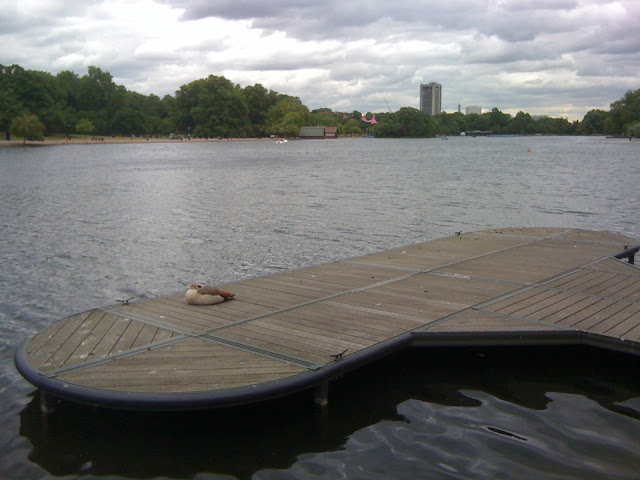We all love a Royal Wedding, don’t we? We were all given a day off work so we could sit in front of the TV for hours, coo over dresses and hats, and celebrate all that’s great about Britain (i.e. the Royal Family - a fundamentally undemocratic system of choosing our head of state). Or, thanks to that day off work, we could choose to spend some quality time with our families in the quieter-than-normal countryside.
Unsurprisingly, our family decided on the latter option, with a trip to the Lake District to take a walk, have a picnic, and view
the Bassenthwaite Ospreys from Dodd Wood.
Before I go any further, I should say that I have nothing against the couple who were getting married – all the best of luck to them, in fact – but, as my wife pointed out, I wouldn’t have survived more than five minutes watching their wedding, and particularly the
build up to their wedding. Listening to hours of mindless drivel from royal correspondents, fashion commentators, and sloany rich kids about “pageantry”, “royal destiny”, and “fascinators”, would make the chip on my shoulder get very, very twitchy. And I reserve particular anti-monarchist ire for
the groom’s wildlife-loving brother: best man Prince Harry.
So, on Friday 29th April 2011, we escaped all that and shot off to the Lakes. The weather was great and the journey straightforward, and there was plenty of space at the Dodd Wood car park. We made our way to the upper view-point nice and quickly - apparently 45 minutes in "RSPB-time" (they always assume you walk at a snail’s pace); about 25 minutes in real time. We even got a to see a Red Squirrel just by the path.
So what, exactly, was I disappointed about? Well, it was the Ospreys - or, rather, the view of the Ospreys – that the Royal Society for the Protection of Birds led us to believe we would get. According to their
Ospreywatch site, "Our open air viewpoints offer spectacular views of the Ospreys on and flying to and from their nest". We didn’t really get much of a view at all. Instead, we get an incredibly dim and distant view of a nest from the other side of a valley, with a tiny spec – the female’s head – poking out of the top.
The thing is, I’m a birder, and I know that wildlife lives by its own rules, and if a bird doesn’t show, then it doesn’t show – fair enough. But the Ospreys do show – the RSPB has telescopes trained on their nest, so you can see them all the time. But they put the viewing point so far from the nest that even more experienced birders can hardly tell what they’re looking at. Then, they invite us all to see the great spectacle of these birds, and put up massive close-ups of Ospreys on the walk up to the viewing points, getting children and adults alike excited at the prospect of seeing these great birds. When we get there, the view way too distant to satisfy anyone, and certainly not one to inspire kids. We are told we can see the birds hunting over the lake, but again, you’d need some powerful optics, which most casual visitors, and more importantly their kids (i.e. the ones we want to attract to nature) do not have.
It wouldn’t disturb the birds to put the view point closer to the nest – like within a mile of it maybe. They certainly won’t stop determined egg-collectors or other persecutors by putting one so far away. It’ll only put off people making the journey to see these birds, because the dissatisfaction they felt, which was obvious in the expressions of some of the people as they came back down the track.
Now, I really like the RSPB – I’ve been a member for years (including when I was as a child back in the 70s), and I even volunteer for them; so I don’t go along with the minority of po-face and snobbish birders who have a pop at them at every opportunity.
What I'm saying is: don't pin all your hopes (and your children's hopes) on great views of Ospreys from the RSPB's viewpoint. It's a nice walk up there, but you if you really want to see Ospreys, you might want to try a different tactic. On a previous visit we drove across to the layby on the A66, on the other side of Bassenthwaite Lake (still well away from the the nest site). From here you can look east across the lake to view the Opreys hunting, and look west to the high ridge, where we saw an Osprey hanging on the updraft. My two-year-old daughter could pick that one out with little assistance. And I'm sure, with a bit of research, there are other places to get good views from too.
Anyway, I feel bad now - I didn't start writing a blog so I could spend all my time whinging about things. One thing certainly had changed in the four years since our last visit: my daughter’s skill with binoculars...
Dodd Wood, Cumbria, 29th April 2007
Dodd Wood, Cumbria, 29th April 2011
And I guess, in the interests of balance, I should also post a picture of my son. Here he is, on his first twitch, at
Potteric Carr YWT reserve near Doncaster, watching breeding Black-necked Grebes.
My son, the twitcher - Potteric Carr, South Yorkshire, 5th June 2009

























